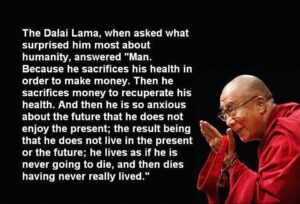Hey Santa Fe! Get Off Your Tush!
Sitting is the New Smoking, but is Standing the Answer?
It’s no secret that people today suffer from a lack of physical activity.
In 2005, the American Cancer Society did an 18-year study with 123,000 subjects and found the death rate was higher in those who sit more than six hours per day.
Studies have found that too much sitting results in an increased risk for heart failure and disability.
These statistics sound a lot like those that come along with smoking and excess sitting is now being called the new smoking. The solution has been to stand up more.
Standing desks are becoming an increasingly popular item in offices across the world.
The adjustable-height desk company UpDesk, has doubled its sales in the past two years, and is predicting similar growth in the future.
There’s also some evidence that backs this up as a real answer to the problem.
A number of studies have been done on the effects of standing and they show that decreasing the time you’re sedentary has huge benefits for overall health.
For instance, a study done in 2012 found that if a person limited their sitting time to three hours per day, life expectancy climbed by two years.
Simple enough, right?
Just stand up at work and all your health problems will be solved.
Well, it might not be as simple as that.
Dr. Jos Verbeek, a health researcher at the Finnish Institute of Occupational Health, says there are some real problems with the research done on standing desks.
Dr. Verbeek claims, “What we actually found is that most of it is, very much, just fashionable and not proven good for your health.”
He adds that there just simply isn’t evidence that standing all day has benefits over sitting.
While you do burn extra calories from standing, its barely the equivalent of a couple banana chips.
Lucas Carr, a behavioral medicine professor at the University of Iowa, argues that while the single-day benefits might not be much, over the course of several years, those extra calories burned can really add up.
Actually, there might be some strong data that indicates standing can be bad for your health.
A 2005 study found that prolonged standing at work led to a higher hospitalization risk for enlarged veins.
Standing too much can also compress the spine and cause lower back problems.
There’s another problem associated with standing desks.
Some users have reported that they are less productive. They’re too busy focusing on forcing themselves to stand to get anything done.
So if sitting is the new smoking, but standing isn’t the best answer, what can we do?
Luckily, there are some practical things you can do to get out of the chair and boost your health.
Dr. Verbeek thinks that a complete overhaul of work environments is one way to encourage movement.
“For example, organize a printer in the corner that’s further away from your desk, or make one bathroom upstairs and restrict use of elevators to people with disabilities.”
Alan Hedge, a professor of ergonomics at Cornell University says that for every half hour spent at work, you should try to sit for 20 minutes, stand for 8 minutes, and move around or stretch for 2 minutes.
Dan Buettner of National Geographic studies Blue Zones, areas on Earth where people live the longest.
One of these is Okinawa, Japan, where people do all of their sitting on the ground, forcing them to get up and down several times throughout the day.
Buettner notes that in these Blue Zones, walking is the main mode of transportation. He claims that walking is the only proven way to prevent cognitive decay.
While standing desks aren’t the best answer, they can be a tool you use to decrease the amount of time you spend sedentary.
Whatever method you choose, the ultimate goal is to increase your daily activity in some shape or form.
Whether you’re walking, standing, sitting on the ground or in a chair, making little changes in your work habits can have big payoffs for your health.
Find out more @


